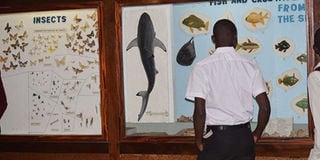Among Nilotes, letter ‘O’ has a religious history

Kisumu Museum Gallery serves as a learning centre. PHOTO | FILE | NATION MEDIA GROUP
What you need to know:
- The letters “O” and “A” originally served as the respective masculine and feminine equivalents of the English definite article ‘the’.
A reader e-mails to ask: “Why are the Luo so preoccupied with the letter “O”? My answer is that I don’t know.
But, in Luoland, a good percentage of all nominal words begin with an “O”. Even more astonishing, whenever the Luo borrow a noun from a foreign language, the likelihood is that the original prefix will be replaced by an “O”.
Thus kijiko, the Kiswahili word for a spoon, has come into Dholuo as ojiko, and kitanda, the Kiswahili word for a bed, has been borrowed as otanda. It is not that the Luo did not have words for these things. Though forgotten, ng’angu was the Luo word for a bed.
As Asenath Odaga reports in her recent DholuoEnglish Dictionary, foreign words have killed scores of other indigenous Dholuo words.
The Kiswahili punda (donkey) has long killed the Luo word kanyna. Chumbi, from the Kiswahili chumvi (salt), has banished the Luo kado, and wembe, the Kiswahili for a shaving blade, has taken over from the Luo mirich.
The letters “O” and “A” originally served as the respective masculine and feminine equivalents of the English definite article ‘the’.
Since most births were identified with the sun’s position, perhaps “O” and “A” were simply the article ‘the’ and — depending only on the gender — ‘Ochieng’ or ‘Achieng’ was simply ‘the Sun’ (from chieng’, ‘sun’).
DEFINITE ARTICLES
The Kalenjin express this filial link as arap, Hebrews as ben, Arabs as bin or ibn, Portuguese as da or do, French as de, Italians as di, English as fitz, Irish (alternatively) as mac, Scottish as mc, Dholuo as maka or wuod, Maasai as ole, Dutch as van, Russians as vich, Germans as von and Kikuyu as wa.
In Portuguese, as in Dholuo, “O” and “A” serve as masculine and feminine definite articles. Oporto (the maritime city) simply means “ the Port”, and Alucha — the “feminine” word in the invocation “Alucha continua” — simply means “ the struggle”.
The Irish “ O” probably just means “of” or “offspring of”. It may not be farfetched to trace the “O” to the Goidels or Tuatha de Danann, an Irish tribe which, as Nora Chadwick suggests in her book The Celts, came from the Nile valley.
The ancient inhabitants of the Nile, Jordan, Euphrates, Indus, Ganges, Brahmaputra continuum considered the circle the most sacred of all figures.
In Genesis of the Grail Kings, Laurence Gardner identifies the veneration with two vital facts. One is that if a snake coils its body so as to suck its tail, the result is an “O”.
SACRED CREATURE
The other is that whenever your thumb meets your forefinger, they also form another “O”. The link is that the evolutionary freeing of an ape’s forelimbs to turn them into mankind was what enabled the “precision grip” that has governed all of humanity’s technocultural history.
In that same riverain continuum, the snake was a deeply sacred animal. Before the Jewish patriarchs turned the creation story upside down to belittle matriarchy (the Goddess Eve) and the Serpent (her Demiurge), the Serpent was the same entity as the Tree of Knowledge.
Its ability to slough the skin and thus seem to live for ever identified him also with the “O” or the Tree of Life. Among the Nilotes, then, the letter “O” has a long religious history.
Philip Ochieng is a veteran journalist





